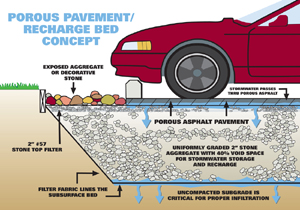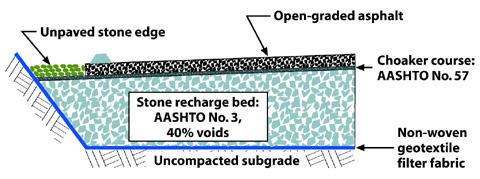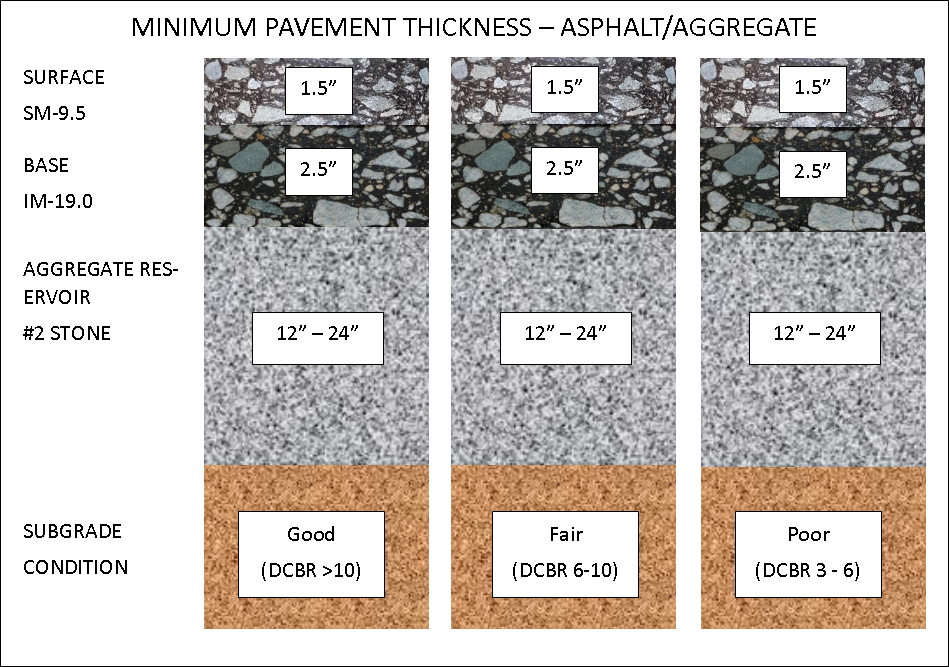 Please note – The primary objective of parking lot design is to provide safe, efficient vehicular access to parking stalls that serve businesses, commuter lots and residential facilities. For businesses and commuter lots, the design must consider the use of the pavement by buses, trucks and other heavy vehicles. This page addresses some basic considerations that should be evaluated in the design and construction of porous parking lots which are used to manage stormwater. Many localities have established certain standards and requirements for parking lots, as has the Virginia Department of Transportation, but very few have requirements for porous parking lots. The Virginia Department of Conservation and Recreation has published standards and requirements for porous pavements in the use of managing stormwater. All applicable sections of these state and local requirements should be followed. The information contained herein is provided as an additional reference source for basic design and construction considerations.
Please note – The primary objective of parking lot design is to provide safe, efficient vehicular access to parking stalls that serve businesses, commuter lots and residential facilities. For businesses and commuter lots, the design must consider the use of the pavement by buses, trucks and other heavy vehicles. This page addresses some basic considerations that should be evaluated in the design and construction of porous parking lots which are used to manage stormwater. Many localities have established certain standards and requirements for parking lots, as has the Virginia Department of Transportation, but very few have requirements for porous parking lots. The Virginia Department of Conservation and Recreation has published standards and requirements for porous pavements in the use of managing stormwater. All applicable sections of these state and local requirements should be followed. The information contained herein is provided as an additional reference source for basic design and construction considerations.
What is Porous Asphalt Pavement?
Porous asphalt pavement is a paved surface and subbase comprised of aggregates and asphalt binder, designed, placed and compacted in a manner resulting in a highly permeable asphalt concrete surface (approximately 17% voids). Porous asphalt pavements offer developers and planners a new tool in their toolbox for managing stormwater. These pavements, used mostly for parking lots, allow water to drain through the pavement surface into a stone recharge bed and infiltrate into the soils below the pavement. The pavement may also be designed to receive off-site runoff.
Such pavements have been proving their worth since the mid-1970s, and recent changes in stormwater regulations have prompted many consulting engineers and public works officials to seek more information about them.
Porous Asphalt Parking Lots
Parking  lots are paved areas intended for vehicle parking and can vary widely in size, function, and design. The types of vehicles that use a parking lot vary and parking lots serve businesses, schools, commuters and other functions. Some lots are small and service primarily automobile traffic, while others can be quite large and have buses and/or trucks traffic. These heavier vehicles are usually isolated to specific parts of the lot or travel the same path in the lot and the pavement in those areas must be designed for their increased pavement loading. This page gives some general guidance when designing at-grade parking lot pavements using permeable asphalt materials. Specific design criteria can be found at the VDOT website (www.virginiadot.gov) or the Virginia Department of Conservation and Recreation website (www.dcr.virginia.gov).
lots are paved areas intended for vehicle parking and can vary widely in size, function, and design. The types of vehicles that use a parking lot vary and parking lots serve businesses, schools, commuters and other functions. Some lots are small and service primarily automobile traffic, while others can be quite large and have buses and/or trucks traffic. These heavier vehicles are usually isolated to specific parts of the lot or travel the same path in the lot and the pavement in those areas must be designed for their increased pavement loading. This page gives some general guidance when designing at-grade parking lot pavements using permeable asphalt materials. Specific design criteria can be found at the VDOT website (www.virginiadot.gov) or the Virginia Department of Conservation and Recreation website (www.dcr.virginia.gov).
Design Considerations
Most pavement designs are based on the traffic using the road when the construction is completed. However, with the construction of parking lots, the heaviest traffic using the majority of the parking lot is during the construction phase. Once the parking lot is completed, cars will be in the parking stall areas and trucks or buses will be in identified drive lanes or ring routes.
Unlike standard parking lots, permeable parking lots are constructed with little to no construction traffic traveling on the stone reservoir or subsequent asphalt layers. It is important the pavement structure is not compacted in the areas of the paving stalls. Specific design and construction details are available on the VDOT website.
Pavement Structure and Materials
The pavement structure and materials are standard in Virginia. Permeable pavements consist of an uncompacted subgrade, a filter fabric, a layer of reservoir stone (12 inches to 24 inches thick), and permeable asphalt concrete. For very weak soils or those that have low infiltration rates, underdrains may be necessary. Each layer is the compacted thickness.
Table 1 –Asphalt with Aggregate Sub-Base Pavement (Parking Stall Areas)
Table 2 –Asphalt with Aggregate Sub-Base Pavement (Truck/Bus Drive Lanes)
Notes:
- Design CBR is defined as 2/3 of the soaked CBR value.
- VDOT Specifications for SM-4.75, SM-9.0, SM-9.5, IM-19.0, and BM-25.0 can be found in Section 211 of the VDOT, Road and Bridges Specification Book.
- VDOT Specifications for #2 aggregate can be found in Section 203 of the VDOT, Road and Bridges Specification Book.
Future Maintenance Considerations
In time, pavement failures may occur due to settlement or weakening of the soil or aggregate base layers. These will result in localized failures or potholes. To repair these failures, the area impacted should be cut out and the pavement material removed to the aggregate reservoir. The removed pavement material should be replaced with new asphalt concrete or a permanent asphalt patching material.
References
- 2016 VDOT Road and Bridges Specifications
- VDOT Special Provisions to the 2016 Road and Bridges Specifications
- VAA Pavement Design Manual




